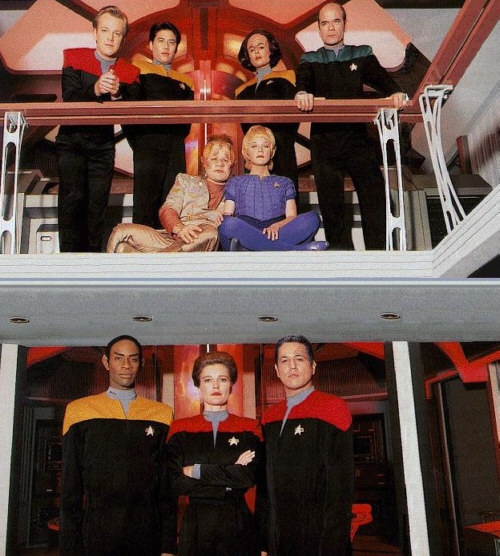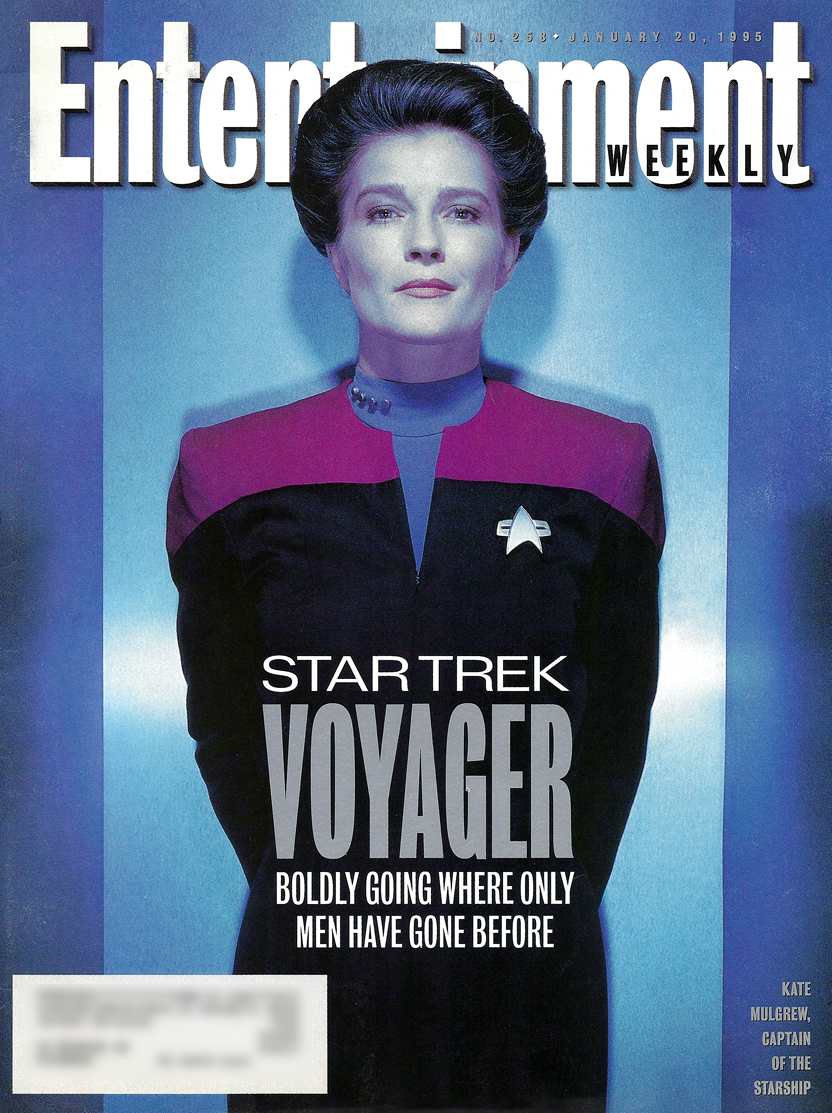PTBN’s own Steve Rogers was kind enough to write about the hype that was being built for Star Trek: Voyager toward the end of 1994.
We Have No Idea of the Dangers We’re Going to Face: Voyager on the Horizon
As Star Trek: The Next Generation was winding down its TV run and preparing to jump to movies, Paramount was gearing up to keep the fires burning and add a new program to run alongside Deep Space Nine.
This venture, though, would be a little more adventurous than what came before it. For one, it was to be the flagship show of a brand new network. For the first time since 1969, Star Trek would return to network television. And so, on January 16th of 1995, the United Paramount Network would launch with the two-hour Star Trek: Voyager premiere episode, “Caretaker.” For what it’s worth, and somewhat ironically considering the show has been airing on SyFy since October of 2010, UPN’s final broadcast on September 15th 2006 was WWE SmackDown!.
Now, the story of how UPN came to be, and its existence as a whole, is an interesting one, but this is more concerning Voyager, and the Star Trek corner of Paramount’s television empire. While Voyager and its successor in UPN’s lineup, Enterprise, would not achieve the success that UPN would have hoped, it was an important time in the history of the Star Trek franchise. Seven years and 172 episodes on network television, even if it disappointed as the “favored son” of the network, is nothing to sneeze at, especially for a sci-fi genre show.

What was setting Voyager apart were premises that the show was setting up. First, the Star Trek canon was about to leave the fate of the Alpha Quadrant and various threads started in Next Generation (such as the Klingon political intrigue) squarely in the capable hands of Deep Space Nine. In a way, this was Trek “getting back to where you once belonged.” True, a good bulk of Next Generation episodes can be boiled down to exploration of strange new worlds and new civilizations, but the show was getting more and more into…well, here is what Q said the final episode “All Good Things…”:
Of being inferior. Seven years ago I said we’d be watching you, and we have been, hoping that your ape-like race would demonstrate some growth, give some indication that your minds have room for expansion. But what have we seen instead? You worrying about Commander Riker’s career, listening to Counsellor Troi’s pedantic psychobabble, indulging Data in his witless exploration of humanity.
Q’s comments later in the episode were perhaps intended to help whet the viewer’s appetite for what was to come with Voyager, as well as the continuing Deep Space Nine, and of course The Next Generation‘s upcoming big screen adventures:
You just don’t get it, do you, Jean-Luc? The trial never ends. We wanted to see if you had the ability to expand your mind and your horizons. And for one brief moment, you did. …For that one fraction of a second, you were open to options you had never considered. That is the exploration that awaits you. Not mapping stars and studying nebulae, but charting the unknowable possibilities of existence.
Not that popcorn sci-fi television could get that heady, but the idea was to get back to its roots of a singular vessel, all alone in the night. Granted, the original Enterprise was never far from Federation outposts or subspace channels, but the show was to be based on the mission of “boldly going where no one has gone before.”
There would be some well-known visitors (most notably the Borg, but Voyager does enter their space, which was established in the species’ debut episode in Season 2 of Next Generation), but the premise of a lost ship some 70,000 light years from home in the remote Delta Quadrant did leave some exciting possibilities for “strange new worlds, new life and new civilizations” in the way the franchise hadn’t really done on a consistent basis since Next Generation‘s early days. (Deep Space Nine was more about the new life and civilizations coming to them, and by the time Voyager starts, the new species and worlds would start to dwindle.)
Thrown into that mix was another Star Trek first, a woman in the leading role. At first Kathryn Janeway was to be portrayed by Geneviève Bujold, who dropped out days after shooting began when she found herself unprepared for what the role would entail press-wise, and having conflicts with other cast members. Kate Mulgrew would be brought in to play the role that to this day is a divisive one in fandom. Not to say there wasn’t deep-rooted misogyny involved in the Janeway hate early on, but certainly the character would bear out actual reasons to rank her lower than other Trek leads. Considering sci-fi/fantasy/horror fandom’s general lack of positive reception to anything that dramatically changes the status quo of their favorite fictional franchise, one could see that being the more overbearing factor in her divisiveness than the gender of the main character. After all, there was a vocal part of the fandom that rejected the notion that a bald headed and cerebral Shakespearean Brit could fill the shoes of a ham fisted all-American…well, portrayed by a Canadian man of action hero like James Kirk (hey, Picard was supposed to be French anyway). Janeway can also be seen, though, as part of the changing status quo for female lead characters in sci-fi/fantasy/horror television. Some 30 years earlier, Majel Barrett’s “Number One” character was the Enterprise’s First Officer in Star Trek’s first pilot, “The Cage,” only to be dropped when a second pilot was commissioned. Around the same time as Voyager‘s debut, Xena was being developed on Hercules: The Legendary Journeys and Joss Whedon was a few years away from reconstituting his failed movie creation, Buffy: The Vampire Slayer, into genre television gold. Voyager‘s run not being all that successful and the use of Janeway’s character through that run may have diminished her standing and importance in the overall progress of strong leading female characters in the genre’s history, but the character’s creation at the time can be considered a revolution of sorts for her gender in the genre. It’s something that would still be considered a big deal.
The journey home also included the added wrinkle of a crew that didn’t get along, at first anyway, with the Voyager crew being intermingled with a crew from a Maquis ship, the Maquis being a large resistance organization of Federation civilians who lived in areas now considered Cardassian space after a treaty between the Federation and Cardassians. The concept was introduced in a second-season two-part episode of Deep Space Nine months earlier, as a way to set up what would be Voyager‘s conflict. Oddly enough, despite seemingly being added to service an upcoming program (a hated trope in the genre, by both fans and writing staffs), Deep Space Nine would continue the Maquis narrative throughout its run. In any event, the concept of a Federation ship working together with and a band of anti-Federation rebels whom the Federation ship was following in an attempt to capture, in theory, would make for some interesting conflicts as the series went along.
The stage was set, and the series was one of the most anticipated shows of the new season. With the exception of The Next Generation seven years earlier, a Star Trek television series had not had the type of widespread excitement that Voyager was commanding (nor would Enterprise). Unfortunately, for various reasons, it failed to sustain the mainstream exposure that it had at the start of its run. But it was a glimmer of hope for Trek fans that at the apex of the franchise’s popularity, that it could be a sustainable property on television.
